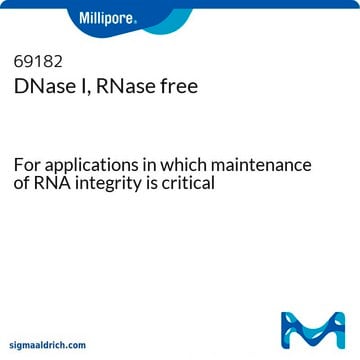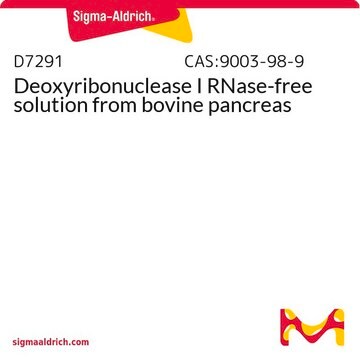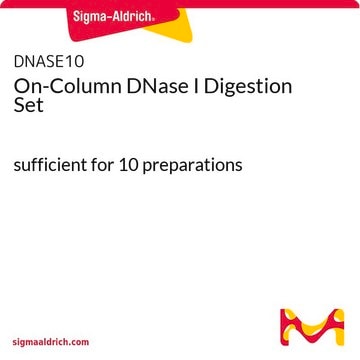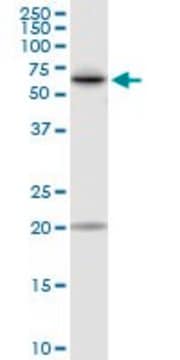The AMPD1 product, DNase I component D5307, is not tested for protein content, so it is not possible to determine the activity units per mg of protein. This variability in active protein content within a preparation makes it more accurate to sell the product based on its unit activity. If the protocol specifies a certain number of milligrams of DNaseI, it is advisable to determine the specific activity of the enzyme used in the procedure. Alternatively, a titration analysis may be necessary to determine the appropriate amount to use.
AMPD1
DNase I
Amplification Grade
Synonyme(s) :
Deoxyribonuclease I
Sélectionner une taille de conditionnement
175,00 $
Disponible pour expédition le02 avril 2025Détails
Sélectionner une taille de conditionnement
About This Item
175,00 $
Disponible pour expédition le02 avril 2025Détails
Produits recommandés
Forme
liquid
Concentration
1 unit/μL
Technique(s)
RT-PCR: suitable
Couleur
colorless
Conditions d'expédition
wet ice
Température de stockage
−20°C
Catégories apparentées
Description générale
DNase I digests double- and single-stranded DNA into oligo- and mononucleotides. Using the Reaction Buffer provided, DNA is removed from RNA preparations in a 15 minute digestion at room temperature. The DNase I is then inactivated by heating with the Stop Solution. Heating also denatures hairpins in the RNA, so the RNA can be used directly in reverse transcription.
No current RNA isolation procedure removes 100% of the DNA. Many commercial DNase I formulations are contaminated with residual RNases. This RNase contamination can destroy or degrade valuable RNA samples prior to reverse transcription. Laboratory comparisons have shown that Sigma′s Amplification Grade DNase I demonstrates lower RNase activity than that from several leading molecular biology product suppliers.
Application
- for the digestion of DNA during isolation and purification of RNA. The purified RNA can be used for the synthesis of cDNA using RNA reverse transcriptase.[1][2][3][4]
- to hydrolyze extracellular matrix (ECM) components and enhance photosensitizer penetration into the biofilm to determine the efficacy of antimicrobial photodynamic therapy (aPDT) on Candida albicans biofilms[5]
- to remove contaminating DNA from total RNA extracted from cattle blood samples[6]
Caractéristiques et avantages
- Suitable for the elimination of DNA from RNA
- Minimal RNase activity available
- Optimized 10× reaction buffer and Stop Solution for complete inactivation of DNase I
Adéquation
Définition de l'unité
Informations légales
Inhibiteur
Produit(s) apparenté(s)
Code de la classe de stockage
10 - Combustible liquids
Point d'éclair (°F)
Not applicable
Point d'éclair (°C)
Not applicable
Faites votre choix parmi les versions les plus récentes :
Déjà en possession de ce produit ?
Retrouvez la documentation relative aux produits que vous avez récemment achetés dans la Bibliothèque de documents.
Les clients ont également consulté
Articles
SeqPlex™-I WTA kit amplifies RNA for NGS, enabling genomic studies from limited samples.
Use of MULTI-seq lipid-modified oligos, protocol, and troubleshooting guide for PCR Assays and Sequencing applications.
Protocoles
Method for reverse transcription of RNA into DNA. Uses a premixed reagent that contains reverse transcriptase, dNTPs, primers, RNase inhibitor and buffer. Fast generation of cDNA.
The SeqPlex RNA Amplification kit provides a method for amplification of total RNA or isolated mRNA prior to entry into the workflows of the commonly used deep sequencing platforms.
Contenu apparenté
The Spectrum Plant Total RNA Kit incorporates a new, patent-pending lysis and binding chemistry. This kit is intended to purify total RNA from species and tissue where most Total RNA protocols fail. Without sacrificing affordability, you can purify more total RNA per isolation.
Polymerase chain reaction (PCR) is a technique for amplifying nucleic acid molecules and is commonly used in many applications, including RT-PCR, hot start PCR, end point PCR and more.
La réaction en chaîne par polymérase (PCR pour "Polymerase Chain Reaction") est une technique d'amplification des molécules d'acide nucléique qui est couramment employée dans de nombreuses applications, incluant la RT-PCR, la PCR à démarrage à chaud, la PCR en point final, et bien d'autres.
KOD One™ PCR Master Mix overview for ultra-fast PCR with high specificity, fidelity, and yield
-
How can I convert 'units' to mass when adding DNaseI to a buffer solution?
1 answer-
Helpful?
-
-
What is the Department of Transportation shipping information for this product?
1 answer-
Transportation information can be found in Section 14 of the product's (M)SDS.To access the shipping information for this material, use the link on the product detail page for the product.
Helpful?
-
-
What do I do if my DNA is not completely digested after 15 minute digestion at room temperature when using Product AMPD1, DNase I?
1 answer-
If further digestion is required, incubation can be performed for 30 minutes at 37°C.
Helpful?
-
-
What is the concentration of the DNAse in Product AMPD1, DNase I?
1 answer-
The DNAse is provided at 1 unit/uL in 1 mL total volume.
Helpful?
-
Active Filters
Notre équipe de scientifiques dispose d'une expérience dans tous les secteurs de la recherche, notamment en sciences de la vie, science des matériaux, synthèse chimique, chromatographie, analyse et dans de nombreux autres domaines..
Contacter notre Service technique


